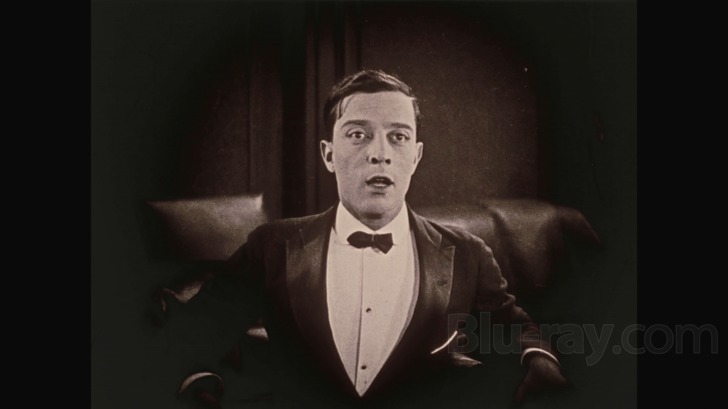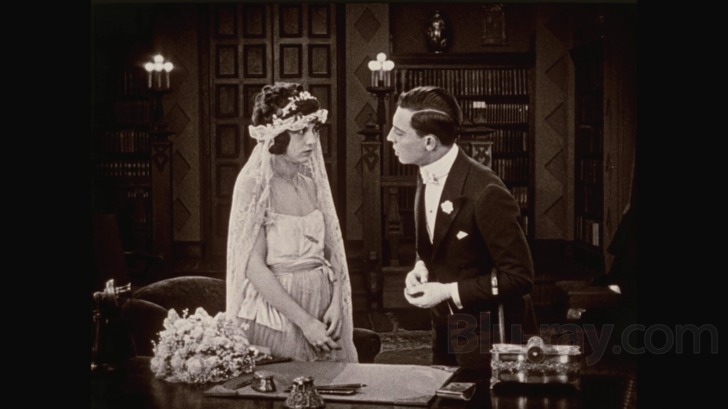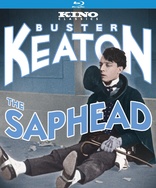The Saphead Blu-ray Movie
HomeThe Saphead Blu-ray Movie 
Ultimate EditionKino Lorber | 1920 | 1 Movie, 2 Cuts | 77 min | Not rated | Jul 10, 2012
Movie rating
6.6 | / 10 |
Blu-ray rating
| Users | 0.0 | |
| Reviewer | 3.5 | |
| Overall | 3.5 |
Overview
The Saphead (1920)
Buster Keaton stars as Bertie Van Alstyne, the pampered son of a powerful Wall Street financier. Having known no other lifestyle but privilege, he wanders through a variety of misadventures—an attempt at courtship, a trip to an illegal gambling den, and a tumble onto the floor of the Stock Exchange—oblivious to the obstacles that stand before him.
Starring: Buster Keaton, Edward Jobson, Beulah Booker, Edward Connelly, Edward AlexanderDirector: Herbert Blaché, Winchell Smith
| Comedy | 100% |
Specifications
Video
Video codec: MPEG-4 AVC
Video resolution: 1080p
Aspect ratio: 1.33:1
Original aspect ratio: 1.33:1
Audio
English: DTS-HD Master Audio 5.1
English: LPCM 2.0
English: Dolby Digital 2.0
Subtitles
None
Discs
50GB Blu-ray Disc
Single disc (1 BD)
Packaging
Slipcover in original pressing
Playback
Region free
Review
Rating summary
| Movie | 3.5 | |
| Video | 4.0 | |
| Audio | 4.0 | |
| Extras | 3.0 | |
| Overall | 3.5 |
The Saphead Blu-ray Movie Review
Buster, but not Buster.
Reviewed by Casey Broadwater June 21, 2012The Saphead isn’t really a Buster Keaton film; it’s a film that happens to star Buster Keaton. Albeit, the first feature to star the
pratfalling former vaudevillian. After three years as a gag writer and actor for producer Joe Schenck and tragic silent icon Fatty Arbuckle’s “Comique”
comedy troupe, Keaton was given his own production unit and a contract to create eight two-reelers a year with almost complete creative control.
Shortly after the first was finished, though—1920’s The High Sign—Schenck loaned Keaton out to Metro Pictures, who wanted him for the lead
in The Saphead, a remake of a 1915 Douglas Fairbanks film that was adapted from a successful Broadway play called The Henrietta.
Fairbanks himself had recommended Keaton for the part, and Schenck realized it would drum up publicity for Keaton and his upcoming comic shorts.
It certainly did. Critics praised his deadpan demeanor, a sophisticated contrast to the broader comedy of the day. “As for Keaton, a cyclone when called
upon” wrote the Variety reviewer, “his quiet work in this picture is a revelation. He is the personification of a mental minus sign in facial
expression.” While The Saphead doesn’t have much to offer storywise—it’s a quaint and somewhat convoluted melodrama—it does give us an
early glimpse at the on-screen persona Keaton would spend the next decade developing: The Great Stone Face. Stoic. Bewildered. In love and out of
luck.

A rare Keaton semi-smile.
Set on then-contemporary Wall Street—during the halcyon days of the 1920s stock market boom—The Saphead first introduces us to the elderly Nicholas Van Alstyne (William H. Crane), a fantastically wealthy New York financier who lives in a veritable castle downtown. His daughter Rose (Carol Holloway) is married to Mark Turner (Irving Cummings), an unsuccessful chump of a broker whose morning mail, an intertitle tells us, is “all bills and no business.” We also learn that Mark has a mistress and an illegitimate child he’s supporting on the sly. So, let’s recap: Mark is short on cash and he has a dirty little secret? Could he possibly be the film’s antagonist?
Keaton plays Van Alstyne’s son, Bertie “The Lamb,” a privileged layabout whom we meet as he’s being served coffee and delicately eating a boiled egg. Bertie’s been out all night carousing, but he’s not naturally accustomed to the “fast” life. He’s a decent-if-unambitious gentleman, who only wants to appear roguish because he’s been reading a book called “How to Win the Modern Girl,” which claims, “Few girls now-a-days can resist a dashing, gambling, drinking devil." The object of his affection—awkwardly—is his adopted orphan sister, Agnes (Beulah Booker), who’s on her way back to New York from boarding school. Bertie’s supposed to meet her at Grand Central, but he absentmindedly goes to Penn Station instead, gets depressed when she doesn’t show up, and wanders into an illegal casino. There’s a wryly funny scene where Bertie—who clearly has no idea what he’s doing— accidentally wins $38,000. When he finds out a single gambling chip is worth two grand, he examines one and asks the dealer with comic earnestness, “What’s it made of?” Later, when the place is raided, Bertie—still wanting to look like a lout—practically begs a cop to arrest him and even tries to hop into the paddy wagon.
He doesn’t have to keep up the tough-guy charade for long. Back home, he blurts out to Rose that he’s in love with Agnes, not realizing Agnes is standing right behind him. She feels the same, fortunately, and soon enough the two are talking marriage. “Old Nick of the Street” doesn’t exactly approve, but he wants the best for his dear adopted daughter, so he cuts Bertie a million dollar check and tells his son he’ll bless the union once Bertie starts working and makes a name for himself. Our hero promptly gets to it, purchasing a seat on the stock exchange for $100,000—“Furniture is way up now-a-days,” he says—and presenting Agnes with an engagement ring. Of course, if the film ended there it wouldn’t be much of a melodrama. Cue the real wastrel, Mr. Turner. When Rose finds a letter from Mark’s paramour, the cheater—also scheming to liquidate Nick’s assets—saves face by saying it actually belongs to Bertie, who gets disowned and dumped. All will eventually be put right, but only after some Wall Street hijinks.
It was said when the film was first released, and it’s just as true now: The Saphead would be utterly unremarkable if it weren’t for Buster Keaton, whose brilliant timing, careful movements, and doleful expressions add some grace to the otherwise prosaic, twice warmed-over material. This is barely a comedy, and for most of the film Keaton has to play it atypically straight. His performance is interesting, though, in that you can see a clear transition from his earlier, hammier roles in Fatty Arbuckle shorts to this new deadpan personality, which would still take some tweaking to get right. (Watch carefully and you’ll see Bertie flash two blink-and-you’ll-miss-‘em grins.) Director Herbert Blaché underutilizes Buster’s physical abilities, but Keaton at least gets to let loose during the chaotic conclusion, a trading floor frenzy that has Bertie buying up stock, hopping into trader’s arms, and—in the film’s only big stunt—getting catapulted across the room and tumbling through a doorway. The gag doesn’t compare to some of the acrobatic insanity we’d see in his later features, but it’s a retrospectively fitting way to end since The Saphead was the film that effectively launched Keaton’s career.
The Saphead Blu-ray Movie, Video Quality 

If you've been collecting Kino-Lorber's other Buster Keaton releases—The General, Our Hospitality, Steamboat Bill, Jr., the Short Films Collection, etc.—you know exactly what to expect from The Saphead's 1080p/AVC-encoded Blu-ray. Overseen by Kino's Brett Wood, the transfer is extremely faithful to it's source material, a 35mm nitrate print originally restored by film collector and archivist Raymond Rohauer, whom Keaton himself entrusted with the preservation of his films. As usual, Wood has taken a relatively hands-off approach, presenting the print as-is, with no attempt to digitally clean it up. I've said before that I'm completely fine with this tact; extensive frame-by-frame restoration is often prohibitively costly, and besides, there's something to be said for being able to see the history of the print in its specks and scratches. The print damage here is comparable to the other Keaton releases and in no way distracting if you're accustomed to watching silent films. There's been no obvious edge enhancement or noise reduction applied either, and the image has a healthy, natural-looking grain structure. The level of clarity easily surpasses earlier standard definition home video releases, and the tinted monochromatic gradation—sometimes purple, sometimes bluish, sometimes straight black and white—features a balanced contrast of deep blacks and bright but not overblown highlights. Another gorgeous release from Kino.
The Saphead Blu-ray Movie, Audio Quality 

The Saphead's Blu-ray release includes the same orchestral score—conducted and composed by Robert Israel—that was featured on Kino's original DVD. And that's a good thing. Israel has a specific talent for creating new silent film scores that complement the onscreen action, rather than overpowering it, and his work on The Saphead is wonderful. I actually found myself unknowingly whistling one of the cues earlier today. The music is presented cleanly and clearly via a lossless DTS-HD Master Audio 5.1 surround track that's mostly front-centric, with the rear channels serving as quiet bleeding room. A Linear PCM 2.0 stereo mix is also available, and both suit the film just fine. The disc includes an alternate cut of the movie— accessible from the "extras" menu—and this features a different, solo-piano score by Ben Model, presented in Dolby Digital 2.0.
The Saphead Blu-ray Movie, Special Features and Extras 

- The Saphead - Alternate Version (1080p, 1:14:33): An alternate cut, comprised entirely of variant takes and camera angles, with a separate piano score by Ben Model.
- A Pair of Sapheads (7:31): A brief documentary that highlights the subtle differences between the two versions of The Saphead, narrated by Brett Wood, who created the new high definition masters.
- Buster Keaton: Life of the Party (Audio Only, 30:34): One of the best obscure extras Kino has dug up for a Buster Keaton release yet. This reel-to-reel audio recording from a home party in 1962 features Keaton entertaining his guests, singing songs, reciting poetry, and telling stories about his vaudeville childhood.
- Why They Call Him Buster (1080p, 1:11): A montage of pratfalls and stunts, created to promote the Kino release of Lost Keaton.
- Gallery (1080p): A collection of sixteen images from Buster's early days in vaudeville.
The Saphead Blu-ray Movie, Overall Score and Recommendation 

Buster Keaton's first feature is atypical in almost every way—it's more melodrama than comedy, it's short on pratfalls, and Keaton had next to no say in the production creatively. This was the role that made him a star, though, and it's worth watching just to see this transitional phase in his career. The Saphead's story is nothing special, but there are at least a few scenes that showcase the young Keaton's comic genius. As you've come to expect from these Kino-Lorber Buster Keaton releases, the Blu-ray presentation is excellent, featuring a beautifully faithful high definition transfer, a lossless audio score by Robert Israel, and some great supplements, including an alternate cut and a rare audio recording of Buster entertaining friends. Recommended!
Similar titles
Similar titles you might also like

Lost Keaton
1934-1937

Buster Keaton: The Short Films Collection
One Week / Convict 13 / Neighbors / The Scarecrow / The Haunted House / Hard Luck / The High Sign / The Goat / The Play House [Playhouse] / The Boat / The Paleface / Cops / My Wife's Relations / The Frozen North / The Electric House / Day Dreams [Daydreams] / The Balloonatic / The Love Nest
1920-1923

College
1927

Our Hospitality
Remastered
1923

The Navigator
1924

Seven Chances
1925

The Cocoanuts
1929

Lost in America
1985

Goin' to Town
1935

Steamboat Bill, Jr.
1928

Battling Butler
Cohen Film Collection
1926

Three Ages
1923

Speedy
1928

Monkey Business
1931

Easy Street
1917

Buster Keaton: The Shorts Collection 1917-1923
1917-1923

Every Day's a Holiday
1937

The Floorwalker
1916

The Adventurer
1917

Shadows and Fog
1991
